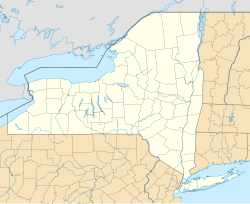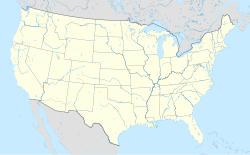Pollepel Island
Pollepel Island /pɒlɪˈpɛl/ is a 6.5-acre (26,000 m2) uninhabited island in the Hudson River in New York, United States. The principal feature on the island is Bannerman's Castle, an abandoned military surplus warehouse.
Description
[edit]Pollepel Island has been called many different names, including Pollopel Island, Pollopel's Island, Bannerman's Island,[1] and Bannermans' Island.[2][3] Pollepel is a Dutch word meaning "(pot) ladle"
The island is about 50 miles (80 km) north of New York City[4] and about 1,000 feet (300 m) from the Hudson River's eastern bank.[3] It covers about 6.5 acres (26,000 m2), most of it rock.[3]
Early history
[edit]Pollepel Island was encountered by the Europeans during the first navigation of the Hudson River by early Dutch settlers in the Province of New York,[5] at the "Northern Gate" of the Hudson Highlands. During the Revolutionary War, patriots attempted to prevent the British from passing upriver by emplacing 106 chevaux de frise (upright logs tipped with iron points) between the island and Plum Point across the river (see Hudson River Chains). Caissons from several chevaux de frise still rest at the river bottom. Still, these obstructions did not stop a British flotilla from burning Kingston in 1777.[6] General George Washington later signed a plan to use the island as a military prison; however, there is no evidence that a prison was ever built there.[5]
Bannerman's Castle
[edit]Bannerman's Island Arsenal | |
 Remains of Bannerman Castle viewed from the railroad on the eastern bank of the Hudson River, circa 2003 | |
| Location | Pollepel Island, Newburgh, New York |
|---|---|
| Area | 13.4 acres (5.4 ha) |
| Built | 1901 |
| Architect | Bannerman, Francis VI |
| MPS | Hudson Highlands MRA |
| NRHP reference No. | 82001121[7] |
| Added to NRHP | November 23, 1982 |
Origin
[edit]Francis Bannerman VI was born on March 24, 1851, in Scotland, and immigrated to the United States with his parents in 1854. His grandfather was from Dundee, Scotland where he worked as a "linenman". The family moved to Brooklyn in 1858 and began a military surplus business near the Brooklyn Navy Yard in 1865 purchasing surplus military equipment at the close of the American Civil War.[8]
In 1867 the business occupied a ship chandlery on Atlantic Avenue engaged in the purchase of worn rope for papermaking. The store on the 500-block of Broadway opened in 1897 to outfit volunteers for the Spanish–American War.[8] The business bought weapons directly from the Spanish government before it evacuated Cuba; and then purchased over 90 percent of the Spanish guns, ammunition, and equipment captured by the United States military and auctioned off by the United States government.[2][9] Bannerman's illustrated mail order catalog expanded to 300 pages; and later became a reference for collectors of antique military equipment.[2][8]
Bannerman purchased Pollepel island in November 1900,[2][3][8] for use as a storage facility for his growing surplus business.[10] Because his storeroom in New York City was not large enough to provide a safe location to store thirty million surplus munitions cartridges,[8] in the spring of 1901 he began to build an arsenal on Pollepel. Bannerman designed the buildings himself and let the constructors interpret the designs on their own.[11]
Most of the building was devoted to the stores of army surplus but Bannerman built another castle in a smaller scale on top of the island near the main structure as a residence, often using items from his surplus collection for decorative touches. The castle, clearly visible from the shore of the river, served as a giant advertisement for his business. On the side of the castle facing the western bank of the Hudson, Bannerman cast the legend "Bannerman's Island Arsenal" into the wall.[2][3]

Circa 1900–1910 the US Navy re-gunned a number of older ships. Bannerman bought the old guns, presumably at scrap value. In 1917, following the American entry into World War I, Bannerman sold a number of these weapons to the US Army, which intended to mount them on new carriages as field guns for the Western Front. Thirty 6-inch (152 mm) 30-caliber ex-Navy guns were acquired by the Army, but sources do not indicate whether any of these were sent to France. The Army's 6-inch gun units in France primarily used former Army coast defense weapons; none of these units completed training and thus did not see action.[12][13]
Construction ceased at Bannerman's death in 1918. In August 1920, 200 pounds of shells and powder exploded in an ancillary structure, destroying a portion of the complex. Bannerman's sales of military weapons to civilians declined during the early 20th century as a result of state and federal legislation. After the sinking of the ferryboat Pollepel, which had served the island, in a storm in 1950, the arsenal and island were essentially left vacant.[4] The island and buildings were bought by New York State in 1967, which took possession after the old military merchandise had been removed, and the relics given to the Smithsonian. For a short time, tours of the island were given in 1968.[5] However, on August 8, 1969, fire devastated the Arsenal, and the roofs and floors were destroyed.[4] Following the fire, the island was placed off-limits to the public.
Current status
[edit]
In the 21st century, the castle is the property of the New York State Office of Parks, Recreation and Historic Preservation and is mostly in ruins. While portions of the exterior walls still stand, all the internal floors and non-structural walls have since burned down. The island has been the victim of vandalism, trespass, neglect, and decay.[14] Several old bulkheads and causeways that submerge at high tide present a serious navigational hazard. On-island guided tours were made available in 2004[15] through the Bannerman's Castle Trust.[16] The castle is easily visible to riders of the Metro-North Railroad Hudson Line and the Amtrak Empire Corridor lines. One side of the castle, which carries the words "Bannerman's Island Arsenal", is also visible to southbound riders.[2][3]

Sometime during the week before December 28, 2009, parts of the castle collapsed. Officials estimate 30–40 percent of the structure's front wall and about half of the east wall fell. The collapse was reported by a motorist and by officials of Metro-North.[17]
On April 19, 2015, the island was the destination of a kayak trip taken by Vincent Viafore and his fiancée Angelika. Viafore drowned, and Angelika was charged with his murder. On July 24, 2017, she pled guilty to criminally negligent homicide and served a short time in prison.[18][19][20][21]
On June 28, 2015, the public art piece Constellation by Beacon-based artist Melissa McGill debuted on and around the castle ruins. The work consists of seventeen LEDs mounted on metal poles of varying heights, which when lighted for two hours each night are intended to create the appearance of a new constellation.[22]
The island is maintained by The Bannerman Castle Trust, a non-profit organization of volunteers who obtain funding to stabilize and improve structures on Pollepel Island and educate the public about the island's history.[23] The Trust also offers guided tours of the island.[24]
In popular culture
[edit]In literature
[edit]Bannerman Castle by Barbara Gottlock and Thom Johnson was released through Arcadia Press in August 2006.[25] The book contains almost 200 vintage photographs, and the authors' text documents the island's growth and decline. Proceeds from the book go to the Bannerman Castle Trust in its ongoing efforts to preserve and improve the island's structures. Wesley Gottlock and Barbara H. Gottlock authored a children's book called, "My Name is Eleanor."[25] It is based on photographs, interviews and journals of Eleanor Seeland. Seeland, an Ulster County resident, lived with her family who were residents of Pollepel Island in the early part of 20th century. Seeland's father was contracted by the Bannermans for about twelve years.
The main characters in Adventures of a Cat-Whiskered Girl by Daniel Pinkwater (2010), set in the 1950s, visit Pollepel Island and hang out with a family of trolls who are squatting in the abandoned castle.[26]
The novel The Devils That Haunt You (ebook 2016 and paperback 2018) by Rick Hoffman, takes place in part on Pollepel Island and features a fictionalized account of its construction and history.[27]
References
[edit]- ^ "Bannermans' Island Photographs". Archived from the original on 2008-07-14. Retrieved 2006-11-17.
- ^ a b c d e f "Bannerman Castle Trust". Retrieved 2006-11-17.
- ^ a b c d e f Beattie, Rich (2006-07-28). "Kayaking to Pollepel Island". The New York Times. Retrieved 2006-11-17.
- ^ a b c Heather, Rebmann. "Explosions on Bannerman's Island". Poughkeepsie Journal. Archived from the original on 2004-06-14. Retrieved 2006-11-17.
- ^ a b c "Bannerman Island History". Retrieved 2006-11-17.
- ^ "Underwater Legacy". Archived from the original on 2006-09-17. Retrieved 2006-11-17.
- ^ "National Register Information System". National Register of Historic Places. National Park Service. July 9, 2010.
- ^ a b c d e Bannerman, David B. (1954) Bannerman 90th Anniversary Military Goods Catalog Francis Bannerman Sons, New York
- ^ Persico, Joseph E. (June 1974). "The Great Gun Merchant". American Heritage. Archived from the original on 2010-05-29. Retrieved 2010-06-19.
- ^ "Bannerman's Arsenal". Retrieved 2006-11-17.
- ^ "Visit to Bannerman's Castle". Archived from the original on 2006-10-15. Retrieved 2006-11-18.
- ^ Crowell, Benedict (1919). America's Munitions 1917–1918. Washington, DC: Government Printing Office. pp. 73–75.
- ^ Williford, Glen (2016). American Breechloading Mobile Artillery, 1875–1953. Atglen, PA: Schiffer Publishing, Ltd. pp. 92–99. ISBN 978-0-7643-5049-8.
- ^ "Panorama from Bannerman's Castle, South Terrace". Archived from the original on 2013-02-20. Retrieved 2006-11-17.
- ^ Randall, Michael (June 5, 2004). "Ghostly Castle Beckons Again". Times Herald-Record. Retrieved 30 May 2023.
- ^ "Bannerman Island Tours". Archived from the original on September 28, 2007. Retrieved 2006-11-17.
- ^ "Walls collapse at Bannerman Castle; officials hope to assess damage as soon as possible". The Poughkeepsie Journal. December 28, 2009. Archived from the original on 16 May 2015. Retrieved 14 May 2015.
- ^ Foderaro, Lisa W. (May 20, 2015). "Couple's Kayak Trip on Hudson Included Mistakes, Experts Say". The New York Times. Retrieved 2015-09-10.
- ^ Foderaro, Lisa W. (2015-11-07). "On '20/20', Woman Charged in Fiancé's Kayak Death Denies She Killed Him". The New York Times. Retrieved 2015-11-10.
- ^ Rojas, Rick (July 24, 2017). "Woman Pleads Guilty in Fiancé's Kayak Death on Hudson River in '15". The New York Times. Retrieved 2017-07-24.
- ^ Stoeffel, Kat (February 26, 2019). "Angelika Graswald Went to Jail for Letting Her Fiancé Drown. The Real Story Is More Complicated". ELLE.
- ^ Phipps, Jillian (24 June 2015). "Local Artist Debuts Constellation Light Display at Bannerman's Castle". Hudson Valley Magazine. Archived from the original on 2015-07-09. Retrieved 2015-07-07.
- ^ staff (29 January 2024). "Bannerman's Island receives over $100,000 state grant for repairs". Mid Hudson News. Retrieved 23 August 2024.
- ^ Croke, Karen (26 July 2017). "Take a tour of Bannerman Castle". Poughkeepsie Journal. Retrieved 23 August 2024.
- ^ a b Gottlock, Wesley; Gottlock, Barbara H. (September 21, 2016). "Child's life on Bannerman Island inspires book". Poughkeepsie Journal. Gannett. Archived from the original on January 30, 2021.
- ^ Gibbons, Ann (June 17, 2010). "Unusual writer, unusual fiction". Daily Freeman. MediaNews Group. Archived from the original on January 30, 2021.
- ^ "The Devils That Haunt You by Rick Hoffman". Goodreads.
External links
[edit]- Castles in the United States
- Fishkill, New York
- Islands of Dutchess County, New York
- Landmarks in New York (state)
- Ruins in the United States
- National Register of Historic Places in Dutchess County, New York
- Islands of the Hudson River
- River islands of New York (state)
- Uninhabited islands of New York (state)



